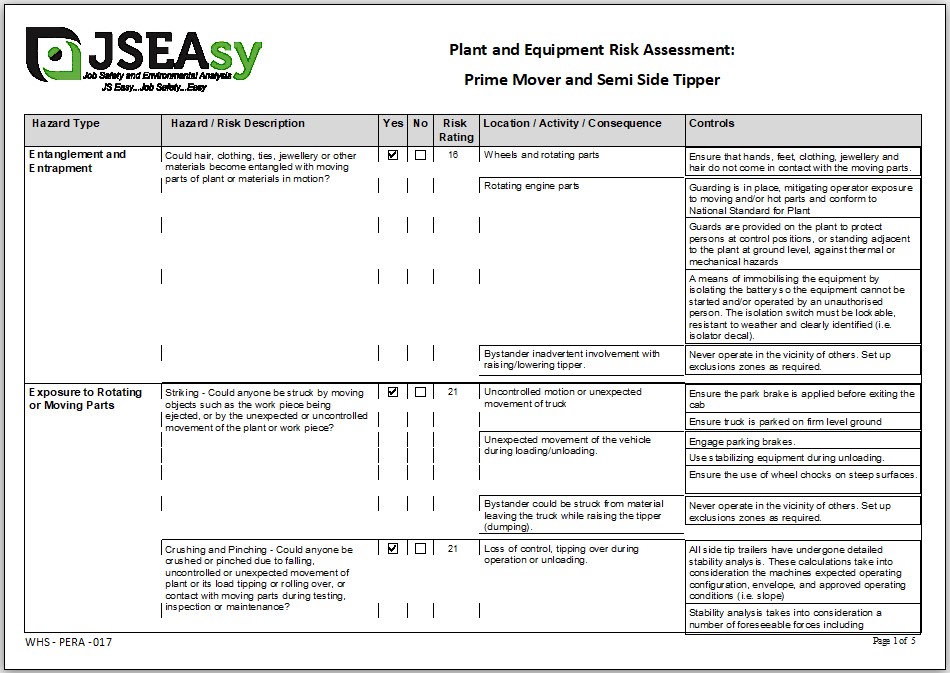Plant and Equipment Risk Assessment for Prime Mover and Semi Side Tipper
Introduction
Welcome to JSEAsy’s comprehensive guide for conducting a plant and equipment risk assessment for Prime Movers and Semi Side Tippers. Ensuring the safety of operators, workers, and the surrounding environment is our top priority. This page will provide a detailed approach to identifying potential risks and implementing effective control measures to mitigate them.
Identifying Hazards
To conduct a thorough risk assessment, we must first identify potential hazards associated with Prime Movers and Semi Side Tippers:
- Operational Hazards: Risks during the operation of the Prime Mover and Semi Side Tipper, such as vehicle instability, tipping, and collisions.
- Loading and Unloading Hazards: Risks associated with the loading and unloading process, including overloading, shifting loads, and falling materials.
- Maintenance Hazards: Risks during maintenance activities, such as exposure to hazardous materials, working in confined spaces, and using heavy tools.
- Environmental Hazards: Risks from environmental conditions, such as adverse weather, uneven terrain, and restricted operating spaces.
- Human Factors: Risks related to human error, inadequate training, fatigue, and non-compliance with safety protocols.
Assessing the Risks
After identifying the hazards, the next step is to assess the risks:
- Severity: Determine the potential impact of each identified hazard (e.g., minor injury, major injury, fatality, environmental damage).
- Likelihood: Evaluate the probability of each hazard occurring (e.g., rare, unlikely, possible, likely, almost certain).
- Risk Rating: Combine severity and likelihood to assign a risk rating (e.g., low, medium, high, extreme).
Implementing Control Measures
To mitigate identified risks, implement the following control measures:
- Elimination: Remove the hazard entirely if feasible (e.g., using different equipment).
- Substitution: Replace the hazard with a less dangerous alternative (e.g., using different loading equipment).
- Engineering Controls: Modify equipment or the environment to reduce risk (e.g., installing load restraint systems, improving vehicle stability mechanisms).
- Administrative Controls: Establish procedures and policies to mitigate risks (e.g., operator training, routine maintenance schedules, site-specific safety protocols).
- Personal Protective Equipment (PPE): Provide and enforce the use of appropriate PPE (e.g., hard hats, high-visibility vests, safety boots).
Monitoring and Reviewing
Continuous monitoring and regular reviews are crucial for maintaining safety:
- Regular Inspections: Conduct routine checks of the Prime Mover, Semi Side Tipper, and associated equipment to ensure they are in good working condition.
- Incident Reporting: Encourage the reporting of near-misses, incidents, and hazards to continually improve safety measures.
- Review and Update: Periodically review and update the risk assessment to reflect any changes in operations, equipment, or regulations.
Specific Considerations for Prime Movers and Semi Side Tippers
- Loading and Unloading Procedures: Follow proper procedures to prevent overloading, uneven loads, and shifting loads during transit.
- Stability: Monitor and control factors affecting the stability of the Prime Mover and Semi Side Tipper, especially during tipping operations.
- Site Conditions: Assess the operating environment for hazards such as steep gradients, soft ground, or obstacles.
- Maintenance Program: Implement a maintenance program that includes regular checks on hydraulics, brakes, tires, and other critical components of both the Prime Mover and the trailer.
- Operator Training: Ensure all operators are adequately trained and competent in using the Prime Mover and Semi Side Tipper safely and effectively.
- Emergency Procedures: Establish and communicate emergency procedures for situations such as tip-overs, mechanical failures, or accidents.
Conclusion
Conducting a thorough risk assessment for Prime Movers and Semi Side Tippers is essential for ensuring safety and preventing accidents. By identifying hazards, assessing risks, implementing control measures, and continuously monitoring and reviewing, you can create a safer working environment for everyone involved in the operation of this equipment.
For more information or assistance with your risk assessment, please contact the JSEAsy safety team. We are committed to helping you maintain the highest standards of safety in your operations.


